I'm working with a large electronic database which records user driven events. Essentially, I want to obtain the proportion/percentages of new users to the service on a monthly basis for an entire year. Below is just a mock example of the data:-
UserId Month UserEventId
Tyrhjj01 Jan 0998907
Fghhey21 Jan 0989892
Hyhkio52 Jan 7782901
hejdoe78 Jan 3889201
Tyrhjj01 Feb 7829930
sjjwilsn Feb 7728910
Tyrhjj01 Feb 9203749
nnkilo89 Feb 7728912
Fghhey21 Feb 4463782
...And so on. As you can see, there are clients who use the service regularly, while some clients are unique in the month of Feb. I want to get a percentage of clients who are old and clients who are unique to the system.I'm attaching an illustration, to help for better understanding.
Percentage of new vs old clients:
 .
.
I have tried a couple of examples from dplyr and data.table but to no avail. Any help would be greatly appreciated!